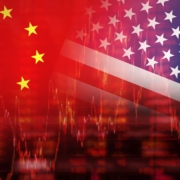Biden Administration Must Maintain Tariffs on Chinese Goods
During his campaign, Biden laid out his economic agenda for the country: “Build Back Better, which includes a $700 billion investment in procurement and research and development for new technologies such as biotech, clean energy, and artificial intelligence.” The goal is that “the new plan will help create 5 million new jobs.” As Vice President under President Obama, Biden advocated engagement with China but changed his tune during the campaign, “calling Chinese President Xi Jinping a “thug. ” While he repeatedly criticized “Trump’s trade and tariff war with China as being ineffective and failing to protect the US economy,” the Biden Administration must maintain the steel and aluminum tariffs to have any hope of achieving his goal.
During his Jan. 19th confirmation hearing, Biden’s incoming secretary of state, Antony Blinken, told the Senate Foreign Relations Committee:
“President Trump was right in taking a tougher approach to China. I disagree very much with the way that he went about it in a number of areas, but the basic principle was the right one. And I think that that’s actually helpful to our foreign policy.”
An article in The Balance reported that the U.S. trade deficit with China was $315.1 billion in 2012 and rose to $367.3 billion by 2015 before dropping to $346.8 billion the following year. By 2018, it had increased to $418.9 billion, before falling to $345.2 billion in 2019.”
The big drop was partly due to the 25% tariff on steel imports that President Trump enacted on top of a 10% tariff previously leveraged on aluminum. The tariffs were enacted on July 6, 2018, impacting $34 billion worth of Chinese imports.
The article reported, “The U.S. trade deficit with China for 2020 was $283.6 billion as of November of that year. That’s 18% less than 2019‘s $345.2 billion deficit.”
The article explained that
“The trade deficit exists because U.S. exports to China were only $110 billion while imports from China were $393.6 billion. The biggest categories of U.S. imports from China are typically computers; cell phones; apparel; and toys, games, and sporting goods.2 A lot of these imports are from U.S. manufacturers that send raw materials to China for low-cost assembly. Once shipped back to the United States, they are considered imports.”
In the same vein, Reuters reported that the U. S. trade deficit narrowed in 2019 for the first time in six years, stating, “At the height of the U.S.-China trade war last year, Washington slapped tariffs on billions worth of Chinese goods, including consumer products, thumping imports. The politically sensitive goods trade deficit with China plunged 17.6% to $345.6 billion in 2019 “
On November 17, 2020, IndustryWeek published an opinion article by Jeff Ferry, chief economist at the Coalition for a Prosperous America Ferry wrote, “it’s clear that the Trump administration’s steel tariffs have generated a boom in steel investment and a shift to newer technologies that are creating high-paying jobs for thousands of new steelworkers…The steel tariffs have succeeded by reducing the level of these imports in the U.S. This has allowed domestic steel producers to make needed investments while taking the industry forward confidently.”
He cited that “U.S. Steel Corporation produced the first ton of steel at a brand-new facility in Fairfield, Alabama, “Nucor Steel has started building a new steel plate mill in Brandenburg, Kentucky, that will employ 400 workers at an average annual salary of $72,800,” and “Commercial Metals Company announced plans to build a second rebar steel mill in Mesa, Arizona, that will employ 185 workers.”
He noted that “With steel imports down, America’s steelmakers have started investing at home. In addition to Nucor and US Steel, companies like Cleveland-Cliffs, Steel Dynamics, CMC, and AK Steel have invested billions of dollars in at least 16 major new projects throughout the nation. The top five US steel companies more than doubled their total annual investments between 2017 to 2019, from $1.5 billion to $4.2 billion.”
It’s been great that the 25% tariffs on steel have saved our critical American steel industry, but the tariffs have not been high enough to benefit most of the manufacturers in the parts-producing domestic supply chain.
As a sales representative for American manufacturers that produce molded and other fabricated mechanical parts, we sometimes get feedback on quotes we lose showing that we would need tariffs of between 200 – 300% to be able to compete with Chinese prices, especially for molded rubber and plastic parts. Sometimes, the finished part price is less than or equal to the prices for the material used to make these parts. Our industry would love for tariffs to be higher and across the board on all products produced in China and imported to the U.S.
As I wrote in my last article of 2020, tariffs have helped manufacturers return to the U.S. through reshoring. We gained business in 2019 and 2020 from companies returning metal fabrication from China to the U.S.
In an article on January 22, 2021, “Biden’s Team Could Be as Hawkish on China as Trump’s, Kenneth Rapoza, CPA Industry Analyst, wrote:
“The Trump Administration got China right. It set the table on China going forward, changing the age-old establishment centerpiece of waiting for allies to okay things following one diplomatic meeting after the next. Lighthizer, Peter Navarro, Wilbur Ross and Trump himself took action, and showed that tariffs on China do not mean prices will rise across the board. The stock market didn’t collapse because of the trade war. There seems to be good momentum on China.”
I urge the Biden Administration to keep up the momentum on reducing our trade deficit with China and increasing higher-paying manufacturing jobs by maintaining or expanding tariffs on Chinese imported goods.
To appease his “Green Deal” followers, he could call the tariffs “Greenhouse Gas Emission fees” because China’s manufacturers depend on polluting coal-fired power plants due to a lack of environmental regulations like we have in the U.S. Many American power plants use cleaner-burning natural gas. The welfare of our economy and national security depend on using every tactic available to thwart China’s goal of becoming the world’s superpower of the 21st Century.











We need to make sure that the tariffs also include agricultural products. China is very quick to jump on any opportunity to turn a profit and that means that they are moving up in exports of crops that were previously grown mainly in other countries. This trend hurts our farmers when they are unable to compete with China’s preposterous price cutting practices. It also hurts our manufacturers when they lose the domestic market and are forced to source materials from China. As is widely known the initial low prices will become quite high once the competition has been removed through unfair trading practices. We have seen them do this over and over again with various industries, let’s get a step ahead of them and nip this toxic trend in the bud.
All of this will be irrelevant if Biden implements the promised tax increases on corporations; thereby making America an inherently uncompetitive nation. This is not a manufacturing-friendly administration.
5 million jobs in China building solar panels and wind turbines doesn’t help American workers or the US economy.